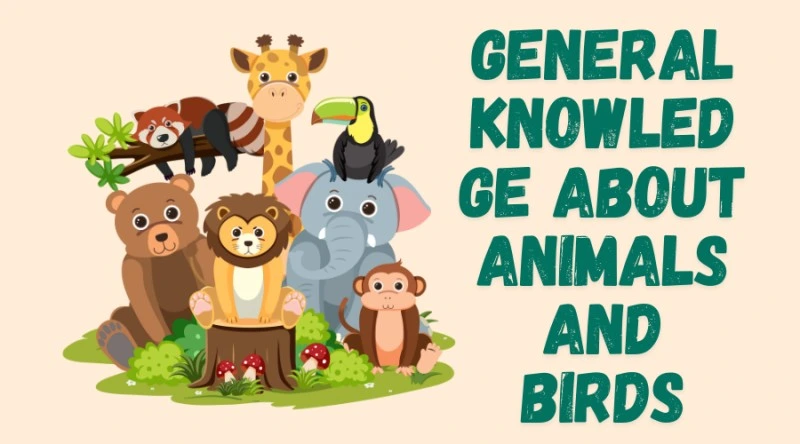Have you ever watched a bird soar through the sky and wondered how it flies so high? Or maybe you've seen a cheetah race across the savanna on TV and been amazed at its speed? The animal kingdom is full of incredible creatures that make our world more exciting! In this blog, I'll share some fascinating facts about animals and birds that will leave you saying "Wow, I didn't know that!"
General Knowledge About Animals And Birds That Will Amaze You
As someone who has spent years watching wildlife documentaries and visiting zoos and nature reserves, I've gathered lots of cool information about our animal friends. Animals and birds come in all shapes and sizes, and each one has special traits that help them survive in their homes. Let's dive into the wonderful world of wildlife together!
Amazing Facts About Animal Kingdoms and Classifications
Did you know there are over 1.5 million different animal species on Earth? Scientists group these animals into categories to help us understand them better.
There are six main animal kingdoms:
- Mammals: Animals that have fur and feed their babies milk
- Birds: Animals with feathers that usually can fly
- Reptiles: Animals with scales like snakes and lizards
- Amphibians: Animals like frogs that live both in water and on land
- Fish: Animals that live underwater and breathe through gills
- Insects: Small animals with six legs and bodies divided into three parts
When I visited the natural history museum last summer, I was amazed to learn that scientists discover about 15,000 new species every year! That means there are still many animals we haven't even found yet.
Incredible Bird Facts That Will Make You Flutter With Excitement
Birds are some of the most incredible creatures on our planet. Here are some facts that always make kids' eyes light up when I share them:
- The ostrich is the largest bird in the world and can't fly, but it can run faster than many horses at up to 45 miles per hour!
- Hummingbirds are the only birds that can fly backward.
- The Arctic Tern makes the longest migration of any animal, flying from the Arctic to the Antarctic and back every year – that's about 44,000 miles!
- Owls can turn their heads almost completely around – up to 270 degrees – to see what's behind them without moving their bodies.
I remember watching a peregrine falcon at a wildlife show once. The trainer told us it's the fastest animal on Earth when diving, reaching speeds over 200 miles per hour! Everyone in the crowd gasped when they heard that.
Wild Mammals and Their Surprising Habits
Mammals are animals that have hair or fur and feed their babies milk. They're found everywhere from the deepest oceans to the highest mountains.
Here are some fun facts about mammals:
- Elephants can communicate with each other from miles away using sounds too low for humans to hear.
- Bats are the only mammals that can truly fly (flying squirrels just glide).
- A blue whale's heart is as big as a small car, and a child could swim through its largest blood vessels!
- Sloths move so slowly that algae grows on their fur, helping them blend in with the trees.
I once watched a documentary about giraffes and learned they only sleep for about 30 minutes a day, usually in 5-minute naps. Can you imagine getting so little sleep?
Ocean Life: Discovering Underwater Wonders
The ocean is home to some of the strangest and most wonderful animals on Earth. More than 70% of our planet is covered by oceans, but we've explored less than 5% of them!
Some amazing ocean facts:
- The blue whale is the largest animal that has ever lived on Earth – even bigger than the biggest dinosaurs!
- Octopuses have three hearts, blue blood, and are incredibly smart – they can solve puzzles and open jars.
- Some deep-sea fish have lights on their bodies to help them see in the dark ocean depths.
- Sea otters hold hands (paws) when they sleep so they don't drift away from each other.
Last year, I visited an aquarium and saw a jellyfish display. I was surprised to learn that jellyfish have been around for over 650 million years – that's before dinosaurs existed!
General Knowledge About Animals And Birds: Record-Breakers
Some animals hold amazing records that show just how incredible nature can be.
Fastest, Strongest, and Biggest Animals on Earth
Let's look at some animal champions:
- Cheetahs are the fastest land animals, running up to 70 miles per hour for short bursts.
- The strongest animal compared to its size is the dung beetle, which can pull 1,141 times its own body weight!
- The elephant is the largest land animal, with African elephants weighing up to 14,000 pounds.
- The peregrine falcon is the fastest animal on Earth, diving at speeds over 200 miles per hour.
I once watched a nature show about ants that can lift 50 times their body weight. If humans could do that, we could lift cars over our heads!
Tiny Creatures with Big Impacts
Small animals can have huge effects on our world:
- Bees pollinate about one-third of all the food we eat. Without them, many fruits and vegetables wouldn't grow!
- Earthworms help keep soil healthy by digging tunnels that let in air and water.
- Plankton are tiny sea creatures that produce more than half of the Earth's oxygen – that's more than all the forests combined!
- Ants can be found on every continent except Antarctica and outnumber humans by about one million to one.
I have a small garden at home, and I always get excited when I see bees visiting my flowers. They're helping plants grow all over the world!
Amazing Animal Adaptations for Survival
Animals have developed incredible features that help them survive:
- Chameleons can change color to match their surroundings and hide from predators.
- Polar bears have black skin under their white fur to help absorb heat from the sun in the cold Arctic.
- Desert animals like camels can go for long periods without water.
- Some frogs can freeze solid during winter and thaw out in spring, still alive!
When I was camping in the desert, I saw a roadrunner zoom past our tent. Our guide explained that these birds can get most of the water they need from the food they eat, so they rarely need to drink!
General Knowledge About Animals And Birds in Their Habitats
Animals live in many different places around the world. Each habitat has its own special animals that are perfectly suited to live there.
Rainforest Creatures: Colors and Camouflage
Rainforests are home to more kinds of animals than any other habitat on land:
- More than half of all animal species live in rainforests, even though rainforests cover less than 6% of Earth's land.
- Toucans have huge, colorful bills that help them reach fruit on branches too small to support their weight.
- Poison dart frogs are brightly colored to warn predators that they're toxic.
- Sloths move so slowly that algae grows on their fur, giving them green camouflage.
I remember seeing pictures of a leaf insect in a book when I was younger. I couldn't believe how perfectly it looked like a leaf – even with fake "bite marks" to make the disguise more convincing!
Desert Dwellers: Masters of Water Conservation
Animals that live in deserts have special ways to stay cool and find water:
- Camels store fat in their humps, not water as many people think. The fat provides energy and water when food is scarce.
- Kangaroo rats never need to drink water – they get all they need from the seeds they eat.
- Desert tortoises can go a year or more without drinking water!
- Some desert lizards do a funny "dance" on hot sand, lifting their feet quickly to keep them from burning.
When I visited the Arizona desert, our guide showed us how barrel cactuses store water inside them. Some desert animals will break open these cactuses during droughts to get a drink!
Arctic Animals: Staying Warm in Extreme Cold
Animals in the Arctic have amazing ways to survive freezing temperatures:
- Polar bears have hollow fur that traps heat and helps keep them warm in the icy Arctic.
- Arctic foxes have fur that changes color with the seasons – brown in summer and white in winter for camouflage.
- Some Arctic birds have feathers on their feet to keep them warm on the ice.
- Walruses have thick layers of blubber (fat) that can be up to 6 inches thick to keep them warm in icy waters.
During a school project on Arctic animals, I learned that snowy owls have special feathers that muffle the sound of their wings when they fly. This helps them sneak up on prey in the quiet Arctic!
General Knowledge About Animals And Birds for Class 7 and Beyond
As students get older, they learn more detailed information about animals and birds. Here are some fascinating facts that might help with school projects:
Animal Communication: More Than Just Sounds
Animals talk to each other in many interesting ways:
- Dolphins use whistles, clicks, and body movements to talk to each other. Each dolphin even has its own "name" whistle!
- Bees do a special "waggle dance" to tell other bees where to find good flowers for nectar.
- Elephants can communicate through rumbling sounds so low that humans can't hear them. These sounds can travel for miles!
- Many animals use scent markers to leave messages for other animals.
When I volunteered at a wildlife center, I got to watch the wolves. The guide explained that they use their tails, ears, and body posture to send messages to the rest of the pack, showing who's the leader and how they're feeling.
Migration Marvels: Epic Animal Journeys
Many animals travel long distances each year in a process called migration:
- Monarch butterflies travel up to 3,000 miles from Canada to Mexico every fall, even though no single butterfly makes the whole trip there and back.
- Arctic terns fly from the Arctic to Antarctica and back every year – the longest migration of any animal.
- Wildebeests in Africa form huge herds of over a million animals that move in a circular pattern following the rains.
- Some humpback whales travel over 5,000 miles between summer feeding grounds and winter breeding areas.
I once watched a documentary about salmon swimming upstream to lay their eggs. They jump up waterfalls and swim hundreds of miles, sometimes returning to the exact stream where they were born!
Endangered Species: Why Protection Matters
Some animals face the danger of disappearing forever:
- There are fewer than 2,000 giant pandas left in the wild.
- Tigers have lost 93% of their natural habitat and only about 3,900 remain in the wild.
- The northern white rhino is nearly extinct, with only two females left in the world.
- Over 1/3 of all amphibian species are at risk of extinction.
I remember feeling really sad when I learned the last male northern white rhino died in 2018. It made me realize how important it is to protect animals before it's too late.
How Humans Can Help Protect Animals and Birds
We all have a role to play in keeping animals safe:
- Reducing plastic use helps keep oceans clean for marine animals.
- Conservation programs help protect endangered species.
- Wildlife corridors give animals safe places to move between natural areas.
- Learning about animals helps us understand why they're important.
My class started a pollinator garden at our school with flowers for bees and butterflies. It's a small step, but it helps these important insects find food!
Fun Facts About Animals And Birds That Will Surprise You
Here are some weird and wonderful animal facts:
- Cows have best friends and get stressed when separated from them.
- Flamingos are born with gray feathers. They turn pink from the food they eat!
- A group of flamingos is called a "flamboyance."
- Goats have rectangular pupils that help them see predators coming from almost any direction.
- Octopuses have blue blood, three hearts, and nine brains!
I remember telling my little brother that a snail can sleep for three years, and he didn't believe me until we looked it up together!
Conclusion: Our Amazing Animal Kingdom
The world of animals and birds is truly amazing! From the fastest cheetah to the tiniest hummingbird, every creature has something special about it. I hope these facts have made you curious to learn even more about the animals we share our planet with. Remember, we all have a part to play in keeping these wonderful creatures safe for future generations to enjoy. Next time you see a bird singing in a tree or a butterfly visiting a flower, take a moment to appreciate how incredible our animal friends really are! What's your favorite animal fact from this blog? I'd love to hear which one surprised you the most!














